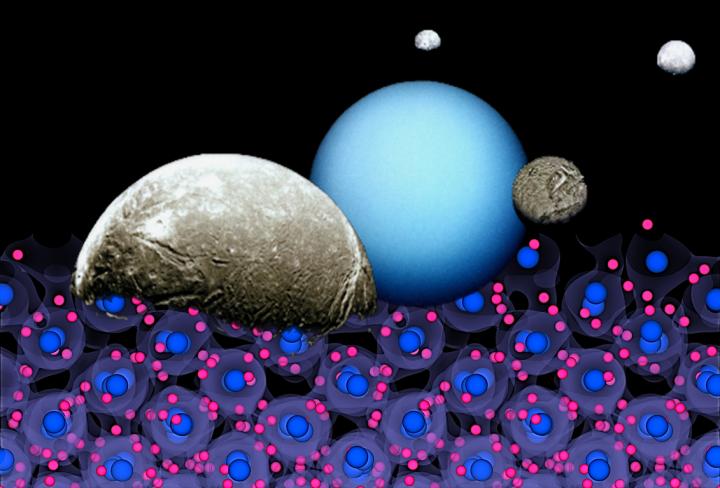By reconstructing on a small scale the physical processes that take place within ice giant planets, such as Uranus and Neptune, a new method of computer simulation allows to shed light on their present structure and past evolution

Credit: Federico Grasselli
A new theoretical method paves the way to modelling the interior of the ice giants Uranus and Neptune, thanks to computer simulations on the water contained within them. The tool, developed by scientists from SISSA in Trieste and the University of California at Los Angeles and recently published in Nature Communications, allows one to analyse thermal and electric processes occurring at physical conditions that are often impossible to reproduce experimentally, with a much easier and low-cost approach. In this research, the scholars have analysed the conduction of electricity and heat of water under extreme temperature and pressure conditions, such as those that occur inside ice-giant planets as well as in many exo-planets outside of it. Investigating the phenomena that occur under their surface, in fact, is key to understand the evolution of these celestial bodies, to establish their age, and to shed light onto the geometry and evolution of their magnetic fields.
Microscopic scales to tell stories of billions of years
“Hydrogen and oxygen are the most common elements in the Universe, together with helium. It is easy to deduce that water is one of the major constituents of many celestial bodies. Ganymede and Europe, satellites of Jupiter, and Enceladus, satellite of Saturn, present icy surfaces beneath which oceans of water lie. Neptune and Uranus are also probably composed primarily of water”, Federico Grasselli and Stefano Baroni, first and last author, explain. “Our knowledge of planetary interiors” – the scholars say – “is based on the features of the planet’s surface and magnetic field, which are themselves influenced by the physical characteristics of their internal structure, like the transport of energy, mass and charge through the internal intermediate layers. That is why we have developed a theoretical and computational method to compute the thermal and electrical conductivity of water, in the phases and conditions occurring in such celestial bodies, starting from cutting-edge simulations on the microscopic dynamics of some hundreds of atoms and incorporating the quantum nature of electrons without any further ad-hoc approximation. By simulating the atomic scale for fractions of a nanosecond, we are able to understand what has happened to enormous masses on time scales of billions of years.
Ice, liquid or superionic: a totally different water
The scholars analysed three different phases of water: ice, liquid, and superionic, under the extreme temperature-and-pressure conditions typical of the internal layers of these planets. Grasselli and Baroni explain: “In such exotic physical conditions, we cannot think of ice as we are used to. Even water is actually different, denser, with several molecules dissociated into positive and negative ions, thus carrying an electrical charge. Superionic water lies somewhere between the liquid and solid phases: the oxygen atoms of the H2O molecule are organised in a crystalline lattice, while hydrogen atoms diffuse freely like in a charged fluid”. The study of thermal and electrical currents generated by the water in these three different forms is essential to shed light on many unsolved issues.
Transport of heat and electricity to understand the past and present
The two scientists also state that “internal electrical currents are at the base of the Planet’s magnetic field. If we understand how the former flow, we can learn a lot more about the latter”. And not only that. “The thermal and electrical transport coefficients dictate the planet’s history, how and when it was formed, how it cooled down. It is therefore crucial to analyse them with the appropriate tools, like the one we have developed. In particular, the heat conduction properties that emerge from our study allow us to hypothesise that the existence of a frozen core may explain the anomalously low luminosity of Uranus as due to an extremely low heat flux from its interior towards the surface.” Furthermore, the electrical conductivity found for the superionic phase is far larger than assumed in previous models of magnetic field generation in Uranus and Neptune. Since superionic water is thought to dominate the dense and sluggish planetary layers below the convective fluid region where their magnetic field is generated, this new evidence could have a great impact on the study of the geometry and evolution of the magnetic fields of the two planets.
###
Media Contact
[email protected]
[email protected]
Original Source
https:/
Related Journal Article
http://dx.




